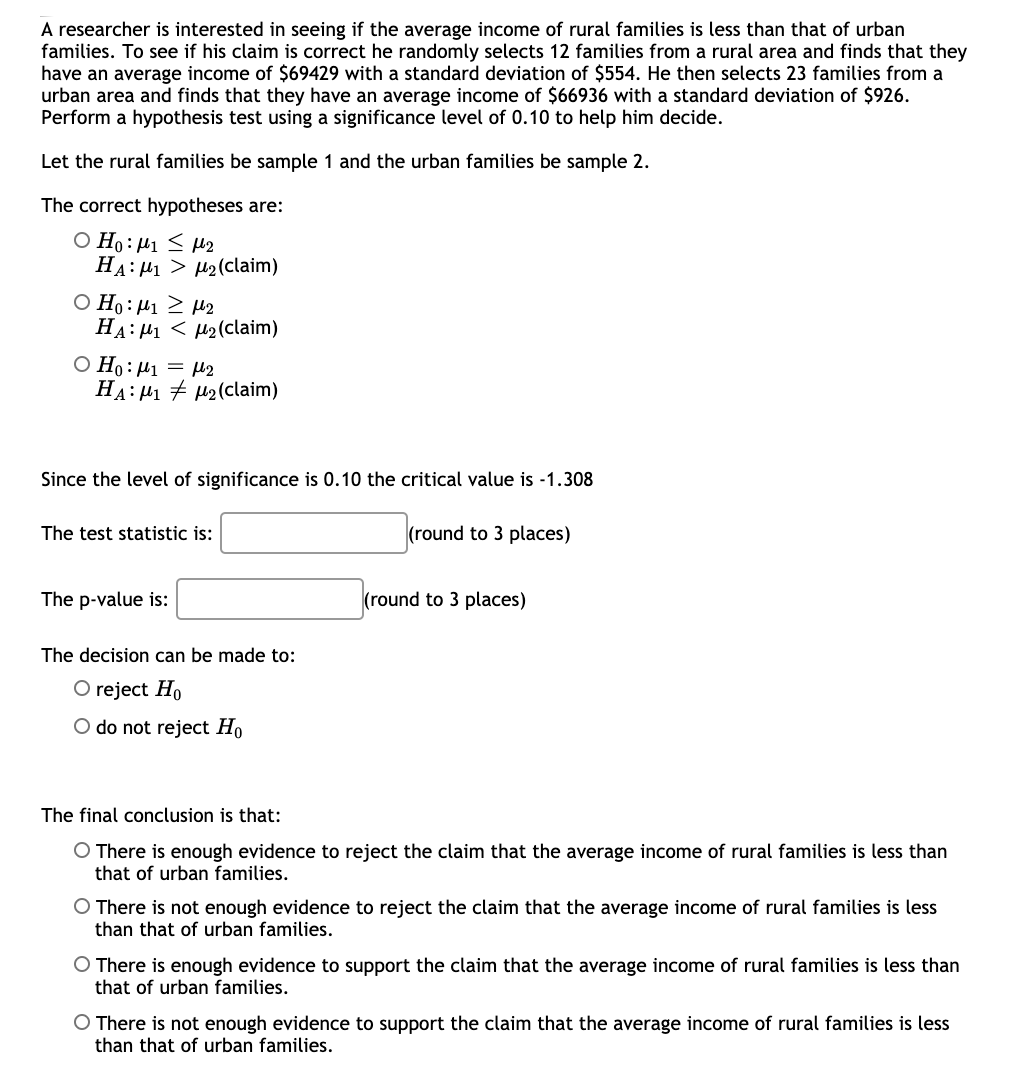A researcher is interested in seeing if the average income of rural families is less than that of urban families. To see if his claim is correct he randomly selects 12 families from a rural area and finds that they have an average income of $69429 with a standard deviation of $554. He then selects 23 families from a urban area and finds that they have an average income of $66936 with a standard deviation of $926. Perform a hypothesis test using a significance level of 0.10 to help him decide. Let the rural families be sample 1 and the urban families be sample 2. The correct hypotheses are: O Ho: µ1 < M2 HA: H1 > µ2(claim) Ο Η: μι > μ2 HA: H1 < µ2(claim) O Ho: H1 = H2 HA: H1 + H2(claim) Since the level of significance is 0.10 critical value is -1.308 The test statistic is: (round to 3 places) The p-value is: (round to 3 places) The decision can be made to: O reject Ho O do not reject Ho The final conclusion is that: O There is enough evidence to reject the claim that the average income of rural families is less than that of urban families. There is not enough evidence to reject the claim that the average income of rural families is less than that of urban families. O There is enough evidence to support the claim that the average income of rural families is less than that of urban families. O There is not enough evidence to support the claim that the average income of rural families is less than that of urban families.
A researcher is interested in seeing if the average income of rural families is less than that of urban families. To see if his claim is correct he randomly selects 12 families from a rural area and finds that they have an average income of $69429 with a standard deviation of $554. He then selects 23 families from a urban area and finds that they have an average income of $66936 with a standard deviation of $926. Perform a hypothesis test using a significance level of 0.10 to help him decide. Let the rural families be sample 1 and the urban families be sample 2. The correct hypotheses are: O Ho: µ1 < M2 HA: H1 > µ2(claim) Ο Η: μι > μ2 HA: H1 < µ2(claim) O Ho: H1 = H2 HA: H1 + H2(claim) Since the level of significance is 0.10 critical value is -1.308 The test statistic is: (round to 3 places) The p-value is: (round to 3 places) The decision can be made to: O reject Ho O do not reject Ho The final conclusion is that: O There is enough evidence to reject the claim that the average income of rural families is less than that of urban families. There is not enough evidence to reject the claim that the average income of rural families is less than that of urban families. O There is enough evidence to support the claim that the average income of rural families is less than that of urban families. O There is not enough evidence to support the claim that the average income of rural families is less than that of urban families.
Glencoe Algebra 1, Student Edition, 9780079039897, 0079039898, 2018
18th Edition
ISBN:9780079039897
Author:Carter
Publisher:Carter
Chapter10: Statistics
Section10.4: Distributions Of Data
Problem 19PFA
Related questions
Topic Video
Question

Transcribed Image Text:A researcher is interested in seeing if the average income of rural families is less than that of urban
families. To see if his claim is correct he randomly selects 12 families from a rural area and finds that they
have an average income of $69429 with a standard deviation of $554. He then selects 23 families from a
urban area and finds that they have an average income of $66936 with a standard deviation of $926.
Perform a hypothesis test using a significance level of 0.10 to help him decide.
Let the rural families be sample 1 and the urban families be sample 2.
The correct hypotheses are:
O Ho: µ1 < H2
HA: 41 > H2(claim)
Ο Η: μι μ2
HA: H1 < µ2(claim)
O Ho: µ1 = H2
HA: H1 + H2(claim)
Since the level of significance is 0.10 the critical value is -1.308
The test statistic is:
(round to 3 places)
The p-value is:
(round to 3 places)
The decision can be made to:
O reject Ho
O do not reject Ho
The final conclusion is that:
O There is enough evidence to reject the claim that the average income of rural families is less than
that of urban families.
O There is not enough evidence to reject the claim that the average income of rural families is less
than that of urban families.
O There is enough evidence to support the claim that the average income of rural families is less than
that of urban families.
O There is not enough evidence to support the claim that the average income of rural families is less
than that of urban families.
Expert Solution
This question has been solved!
Explore an expertly crafted, step-by-step solution for a thorough understanding of key concepts.
Step by step
Solved in 3 steps with 1 images

Knowledge Booster
Learn more about
Need a deep-dive on the concept behind this application? Look no further. Learn more about this topic, statistics and related others by exploring similar questions and additional content below.Recommended textbooks for you

Glencoe Algebra 1, Student Edition, 9780079039897…
Algebra
ISBN:
9780079039897
Author:
Carter
Publisher:
McGraw Hill

Glencoe Algebra 1, Student Edition, 9780079039897…
Algebra
ISBN:
9780079039897
Author:
Carter
Publisher:
McGraw Hill